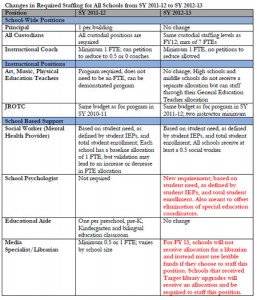Given the hits that health and human services funding took in the Mayor’s Budget, some would say education advocates have less to complain about this year. Even before the budget was released, Mayor Gray announced a two percent increase in the Uniform Per Student Funding Formula that is used to set overall funding for DC Public Schools and DC public charter schools. But, is there more to the story?
The two percent increase allowed DCPS to increase the minimum per-student allotment to individual schools for the upcoming school year, from $8,400 to $8,568, which is primarily an adjustment for inflation. Yet while this increase appears to be a solid investment in DC schools, the reality is that some individual schools will have to do more with less money. Here are a few issues that DCFPI hopes will be explored further during tomorrow’s education budget hearings.
- Costs for many core school functions, like teachers, will rise faster than the two percent funding increase. The average cost per teacher (as well as counselors, instructional coaches, and librarians) is rising 5.4 percent. This partly reflects the fact that teacher performance bonuses under the IMPACT evaluation system — which until now have been have been paid with private foundation fund — will have to be paid with local funds in 2013. Higher teacher costs also reflect rising fringe benefits (like health care) and seniority-based pay increases. Rising costs mean that the two percent increase is not adequate to maintain current school services.
- Middle and high schools will see an increase in class sizes. The middle school teacher: student ratio will be raised to 1:22 (from 1:20) and high school class size will be pegged at 24 (up from 22 this year). Because some high school classes must be smaller — such as Advanced Placement, Career and Technical Education, or smaller classes designed to improve student learning — some high school classes are likely to be far larger than 24. The larger class sizes could be in violation of the Washington Teachers’ Union contract.
- Smaller schools may face greater funding disparity as a result of changes to required staff positions. Many smaller schools will no longer be allocated funds for a librarian in FY 2013. If they choose to hire one, a smaller school will need to use its discretionary (or “flexible”) funds to do so. In this situation, many schools may opt to not have a librarian. Beyond that, other changes to required staffing limit school flexibility, which is likely to affect smaller schools the most, since they tend to have the smallest amount of flexible funds. For example, all schools will be required to have a full-time instructional coach next year, while this year, schools currently have flexibility to have a half-time instructional coach and use the remaining funds for other purposes (The changes in required staffing for DCPS schools from last year to this year are outlined in the table below.)
Finally, an examination of the winners and losers in the school funding allocations shows that this is driven largely by the size of the school and whether the school is growing or shrinking, not by the poverty or other needs of the student population. Indicators of need, such as neighborhood high schools with large truancy rates or schools with a large share of students who are low-income, for the most part do not receive dedicated funding in DC’s distribution of local school funds. The recently completed report of the Public Education Finance Reform Commission recommended that the funding formula be revised in future years to devote extra resources to schools with students who are both low-income and academically behind, and this year’s DCPS allocations reinforce the need for this change.

